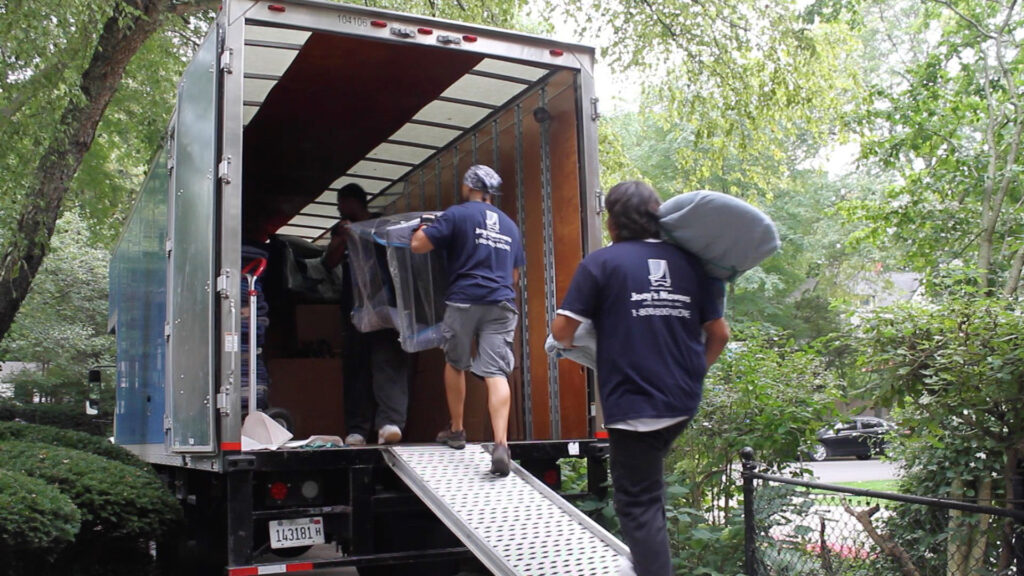Moving can be stressful, especially when handling large or complex furniture. A common question many people ask is,“Do movers take apart furniture?”The short answer is yes—many professional movers offer furniture disassembly and reassembly services as part of their moving packages. However, not all furniture requires disassembly, and some services may come at an additional cost.
In this guide, we’ll explain everything you need to know to make an informed decision about furniture disassembly services, including:
- Why furniture disassembly matters in a move
- What types of furniture movers typically take apart and put back together
- How to anticipate the cost and how to decide if you should do it yourself
Why Furniture Disassembly Matters in a Move
Moving furniture without disassembly may seem easier, but it can lead to unnecessary challenges. Taking apart certain pieces before moving day can make the process safer, faster, and more efficient.
- Prevents Damage.Taking furniture apart reduces stress on weak joints, prevents structural damage, and ensures that delicate surfaces remain intact during transport. Disassembled furniture is also less likely to scrape against walls, door frames, or floors.
- Make Transportation Easier. Movers often disassemble beds, tables, and desks to make them easier to carry and navigate through tight spaces.
- Reduces the Risk of Injuries. Moving smaller, lighter pieces of furniture is much safer than trying to lift an entire piece of heavy furniture.
- Maximizes Truck Space. Disassembled pieces can be stacked and arranged more effectively, optimizing available truck space.
- Reduces Moving Costs. Compactly packed furniture takes fewer labor hours to load and unload. You may also require a smaller truck, which can cut down on rental and transportation fees.
Disassembling furniture is an investment into a safer and more efficient move. Not interested in taking your furniture apart and putting it back together after moving? No problem when you hire Joey’s Movers! Give us a call at (847) 674-7779 or get an online quote.
What Types of Furniture Do Movers Usually Take Apart?
Most full-service moving companies offer furniture disassembly to make transportation easier and safer. However, the level of disassembly depends on the type of furniture, the moving company’s policies, and the specific challenges of your home layout. Here are the most common pieces that movers usually disassemble.
Beds
Beds are often too large to move in one piece, so they are the most common item that movers will disassemble.
- Wooden or metal frames can be bulky. Taking them apart prevents damage during transport.
- Large or decorative headboards are removed to avoid scratches and dents.
- Platform Beds often include multiple components that need to be disassembled for safe transportation.
- Adjustable Beds contain mechanical parts and motors. Having professional movers handle their disassembly ensures that nothing is damaged.
- Bunk Beds take up a lot of moving truck space and often have multiple complex parts, like ladders and built-in shelving. Professional movers who agree to disassemble and assemble a bunk bed can ensure that every piece is carefully accounted for.
If your movers agree to reassemble your beds at your new home, make sure the service is included in the estimate. Otherwise, it may incur additional fees.
Large Tables
Dining tables, conference tables, patio tables, and other large furnishings often need to be disassembled to fit through doorways and into moving trucks. Professional movers help by removing table legs, wrapping delicate surfaces to prevent scratches and cracks, and detaching any expansions or leaves.
Glass-top tables may require extra care and packaging to prevent breakage. Make sure the supplies and labor are included in your moving estimate.
Sectional Sofas
Modern sectionals are designed in multiple pieces, which makes them easier to move. Movers who offer to disassemble and reassemble sectionals typically:
- Separate individual sections.
- Remove legs, armrests, or detachable backrests if necessary.
- Wrap each piece to prevent fabric or leather damage.
If your sectional includes extra components like built-in recliners, surround-sound speakers, hidden beds, or storage compartments, inform your movers so they can handle them properly. Make sure these additions are discussed during the estimate to avoid extra labor and special handling fees.
Bookcases and Shelving Units
Large bookcases with glass panels or modular shelving may require partial or full disassembly. Built-in shelving units may require a handyman or specialized movers willing to perform the task. Make sure to discuss any shelving with your movers prior to moving day to avoid any complications.
Desks
Desks often need to be taken apart for easier transport. Movers that agree to disassemble desks may:
- Separate L-shaped or U-shaped desk components
- Remove drawers, fragile surfaces, built-in stands and storage, and glass tops
- Require special handling before they disassemble standing desks or desks with electrical components
Other Furniture That May Require Disassembly
While the above are the most common, movers may also disassemble:
- Entertainment centers and TV stands
- Wardrobes and armoires
- Cribs and nursery furniture
If you’re unsure if a piece of furniture should be disassembled before moving, ask your moving company for guidance on which pieces they recommend taking apart before transport.
Do Movers Reassemble Furniture at Your New Home?
It depends on your movers and the services they provide. Most full-service moving companies offer reassembly as part of their standard services. However, there are some exceptions. Understanding what’s included and what costs extra can help you plan ahead.
Standard Reassembly Services
If movers disassemble furniture for transport, they often include an option to reassemble it at your new home. This service ensures that you do not have to struggle with reassembling large or complex pieces. Standard reassembly usually includes:
- Beds. Movers will reassemble bed frames, reattach headboards, and position the box springs and mattresses. Some may not cover or charge extra fees to secure a platform or adjustable bed, lighting, hidden storage, and special parts if they were not included in the estimate.
- Tables. Dining tables and conference tables will have their legs and components reattached.
- Sectional Sofas. The modular pieces will be reconnected as they were before disassembly. If applicable, hidden mattresses and storage will be returned to their places.
- Desks. Detachable components will be put back together.
- Bookcases and Shelving Units. Any shelving removed for transport will be repositioned.
- In most cases, all special handling from disassembly is included in reassembly. Anything the movers can not handle should be discussed beforehand.
Even if reassembly is included in the service, it’s always best to confirm the specifics with your moving company before booking.
When Reassembly Might Cost Extra
While standard furniture reassembly is typically included, some situations may lead to additional charges.
- Complex or Custom Furniture. Items like Murphy beds, built-in wall units, or handcrafted furniture often require specialized knowledge and tools. Movers may charge extra for these tasks if they perform them.
- Time-Consuming Assembly. If a piece takes a significant amount of time to reassemble, some movers may charge additional labor fees.
- Missing or Lost Hardware. If essential screws, bolts, or connectors are missing, movers may not be able to complete reassembly. In some cases, they may charge extra for replacement parts to complete the task.
To avoid unexpected costs, ask your moving company in advance about reassembly fees for specialty or time-intensive furniture. Joey’s Movers keeps your move stress-free with transparent pricing from the start! We won’t charge hidden fees for reassembling furniture at your new home or office.
What If Movers Didn’t Originally Disassemble It?
Many moving companies have policies stating they will only reassemble furniture they personally disassembled. This is to prevent liability issues that can arise from not knowing how it was put together or if they were at fault for a broken or missing piece.
If you decide to take apart your furniture before moving, check with your movers beforehand to ensure they will be willing to put it back together at your new home. If not, you may need to handle their reassembly yourself or hire a handyman service.
Do Movers Take Apart All Furniture Automatically?
Not all furniture requires disassembly before a move. Many smaller or structurally sturdy pieces can be transported without any issues. These include:
- Chairs. Dining chairs, office chairs, and accent chairs are usually lightweight and easy to transport without disassembly.
- Nightstands. Most nightstands are compact and sturdy enough to be moved in one piece. Drawers may be secured or removed and packed separately.
- Small Coffee Tables. Unless the coffee table has delicately designed legs or a glass top, it can usually be transported without taking it apart.
- Dressers. Standard-sized dressers can typically be moved as-is. However, extra-large or extremely heavy dressers may need to have drawers removed or be partially disassembled.
If you’re unsure whether a piece should be disassembled, your moving company can advise you based on its size, weight, and structure.
When Movers Recommend Disassembly
Even if a piece of furniture isn’t overly large, disassembly may still be necessary in some situations.
- Tight Spaces. If a piece won’t fit through tight spaces like a doorway, past a built-in structure like a kitchen island, down a staircase, or into an elevator, movers may take it apart to ensure safe transport.
- Fragile Parts. Items with delicate wood, glass panels, or intricate detailing may need to be disassembled to prevent damage.
- Extremely Heavy Items. Large furniture, such as solid wood dressers or oversized desks, is generally easier and safer to move when broken down into smaller, more manageable sections.
- Space Constraints. Movers may recommend disassembling furnishings to save space and help you avoid additional transportation costs.
If you have concerns about specific pieces of furniture, discuss them with your movers ahead of time.
Will Movers Take Apart and Dispose of Unwanted Furniture?
Most moving companies focus on transportation, not disposal. However, some movers offer junk removal services for an additional fee. Some companies, like College Hunks Hauling Junk, provide both moving and furniture disposal services.
Other options include:
- Donation. Give unwanted furniture to local charities.
- Bulk Pickup during your area’s scheduled bulk waste removal. If you are in the Chicago area, you can call 3-1-1 to schedule a free bulk trash pickup.
- Bulk Dropoff to your local landfill. This may require a small fee.
- Hiring Junk Removal Specialists. Companies like 1-800-GOT-JUNK? can remove furniture and other bulk trash for a fee.
Our experts at Joey’s Movers do not offer disposal, but we DO help arrange for the disposal of unwanted items as part of our pre-move decluttering services.
Cost of Furniture Disassembly & Reassembly Services
The cost of furniture disassembly and reassembly depends on the moving company, the complexity of the furniture, and whether it is included in your moving package.
Common situations where movers may charge extra include furnishing items like built-in wall units, Murphy beds, and handcrafted furniture that may require special tools or expertise. These items may also add time and labor costs.
Since policies vary by company, it’s best to confirm with your movers whether this service is covered in your quote.
Typical Pricing Range for Furniture Disassembly and Reassembly
Professional movers and handymen typically charge between$50 to $100 per hourfor furniture disassembly and reassembly during labor-only services. The total cost depends on:
- The number of furniture pieces requiring disassembly.
- The complexity of the furniture.
- Whether special tools or skills are needed.
- The company’s hourly labor rates.
Ask for a detailed estimate, including any potential charges for specialty furniture, to avoid surprises and sticker shock when the final bill is tallied.
Should You Disassemble Furniture Yourself?
While DIY disassembly can save money, it also comes with risks. Understanding the pros and cons can help you determine the best approach for your move.
Pros of DIY Furniture Disassembly
- Saves money on moving costs
- Gives you control over how items are packed
- Can inspect furniture for mold or damage
- Reduces moving time on moving day
Cons of DIY Disassembly
- Risk of losing screws or small parts
- Potential to damage furniture if done incorrectly
- Time-consuming and physically demanding
- Moving crew might not help reassemble
DIY makes sensewhen the furniture is easy to take apart and put back together or if you have plenty of time to prepare. Otherwise, letting the movers handle it may save you time, money, and sanity.
How to Prepare Furniture for Movers
Proper preparation helps ensure your furniture is moved safely and efficiently. Taking a few simple steps before moving day can prevent damage, make loading and unloading more manageable, and help movers handle your items with care.
Clear Off Surfaces and Empty Drawers
Before the movers arrive, remove all items from the furniture, including:
- Books, decor, and electronics from shelves and tables
- Clothes, accessories, and other belongings from dressers and nightstands
- Any fragile or loose items
Pro Tip: While some dressers can be moved with their drawers intact, it’s best to empty them if they are heavy or if movers will be navigating stairs and tight spaces.
Remove Fragile Components
If your furniture has fragile or detachable parts, take them off and pack them separately or set them to the side for movers to do so. This includes:
- Glass tabletops and shelves
- Mirrors attached to dressers or vanities
- Loose or adjustable shelves that could shift during the move
Wrap fragile components in moving blankets or bubble wrap and label them to ensure careful handling.
Keep Hardware Together
It’s important to keep all small parts organized in order to make reassembly easier. Place screws, bolts, and other hardware in labeled plastic bags.
Tape each bag of hardware to the corresponding furniture piece or store it in a designated box. Have a designated bag or box holding the necessary tools as well, so you do not need to dig through your entire collection to hunt them down later.
For complex builds, try to find or acquire downloads of their assembly instructions online. You can often obtain a free copy from the manufacturer. If possible, take photos of the disassembly process to make reassembly easier.
Communicate Special Requests
If any furniture is especially fragile, valuable, or requires extra care, inform your movers ahead of time. This includes antiques, heirlooms, items with delicate surfaces, and specialty pieces that require careful disassembly and reassembly.
Providing clear instructions ensures that movers handle your furniture appropriately and use the right equipment to transport it safely.
Final Recommendations
Movers do take apart furniture, but the level of service varies by company. Standard disassembly and reassembly are often included in full-service moves, but complex or custom furniture may cost extra. To ensure a smooth move, ask about these services when booking movers.
If you’re looking for professional movers who handle furniture disassembly and reassembly with care, Joey’s Movers is here to help. Call us today at (847) 674-7779, or get a free online quote for a hassle-free moving experience.





